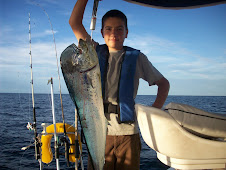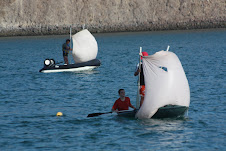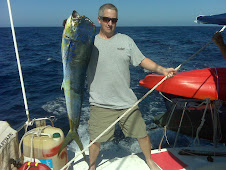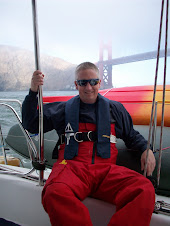 This post is in response to some comments and questions about life with a dog, cruising on a boat.
This post is in response to some comments and questions about life with a dog, cruising on a boat.Nothing is better than waking up in the morning and seeing the goofy, happy face of Rudy, excited to see me after a WHOLE night spent apart. It is just a great way to start the day. Anyone who has been following our blog for long knows that we have gone to extraordinary lengths to keep Rudy healthy, safe and happy while we cruise around Mexico. It is not an easy task. But Rudy makes the effort worthwhile for us. He has put his mark (so to speak) on our time cruising from deciding what boat to buy to where we go.
Bathroom breaks - We are very fortunate since Rudy quickly learned how to u se a 2' x 3' piece of astro turf as his personal potty. It only took him 2 days to figure it out, which is pretty good for him. I know many dogs who require daily trips to the beach to relieve themselves and will hold it for days if they are at sea. I don't know why he picked it up so quickly, but these are the steps we took. We poured some of our pee onto the mat and had it in place before he ever even set foot on the boat. We placed him on the boat and did not let him off until he peed. It took just over 24 hours. He went right to the mat and peed. We gave him a big chunk of raw bacon (first time in his life). About 30 minutes later he had a bowel movement on the mat and we gave him more bacon. And then after that he started running into the galley whenever he used the mat, so we figured he had it down and stopped giving him bacon. He has never had an accident. We keep his mat up on the bow of our boat and when it is dirty, we simply drop it overboard on a line and let it soak.
se a 2' x 3' piece of astro turf as his personal potty. It only took him 2 days to figure it out, which is pretty good for him. I know many dogs who require daily trips to the beach to relieve themselves and will hold it for days if they are at sea. I don't know why he picked it up so quickly, but these are the steps we took. We poured some of our pee onto the mat and had it in place before he ever even set foot on the boat. We placed him on the boat and did not let him off until he peed. It took just over 24 hours. He went right to the mat and peed. We gave him a big chunk of raw bacon (first time in his life). About 30 minutes later he had a bowel movement on the mat and we gave him more bacon. And then after that he started running into the galley whenever he used the mat, so we figured he had it down and stopped giving him bacon. He has never had an accident. We keep his mat up on the bow of our boat and when it is dirty, we simply drop it overboard on a line and let it soak.
 se a 2' x 3' piece of astro turf as his personal potty. It only took him 2 days to figure it out, which is pretty good for him. I know many dogs who require daily trips to the beach to relieve themselves and will hold it for days if they are at sea. I don't know why he picked it up so quickly, but these are the steps we took. We poured some of our pee onto the mat and had it in place before he ever even set foot on the boat. We placed him on the boat and did not let him off until he peed. It took just over 24 hours. He went right to the mat and peed. We gave him a big chunk of raw bacon (first time in his life). About 30 minutes later he had a bowel movement on the mat and we gave him more bacon. And then after that he started running into the galley whenever he used the mat, so we figured he had it down and stopped giving him bacon. He has never had an accident. We keep his mat up on the bow of our boat and when it is dirty, we simply drop it overboard on a line and let it soak.
se a 2' x 3' piece of astro turf as his personal potty. It only took him 2 days to figure it out, which is pretty good for him. I know many dogs who require daily trips to the beach to relieve themselves and will hold it for days if they are at sea. I don't know why he picked it up so quickly, but these are the steps we took. We poured some of our pee onto the mat and had it in place before he ever even set foot on the boat. We placed him on the boat and did not let him off until he peed. It took just over 24 hours. He went right to the mat and peed. We gave him a big chunk of raw bacon (first time in his life). About 30 minutes later he had a bowel movement on the mat and we gave him more bacon. And then after that he started running into the galley whenever he used the mat, so we figured he had it down and stopped giving him bacon. He has never had an accident. We keep his mat up on the bow of our boat and when it is dirty, we simply drop it overboard on a line and let it soak.Food - Rudy eats a 40 lb bag of dog food in about a month. Back home in America we fed Rudy an imported dog food that was 70% protein, 100% hype, cost $80 per 50 lb bag and was only sold in high-end pet stores. They don't even sell that down here. The best brand dog food we can find is Royal Canin and it costs $120 for 40 lb bag. We have only found it for sale in Mazatlan or La Paz. So guess what? Rudy has actually continued to survive just fine eating Purina Dog Food! It costs about $35 for a 50lb bag and it is sold anywhere that is big enough to have a real store. Since it is probably not the most nutritious food, we heavily suplement Rudy's diet with potato peelings, apple cores, tomato ends, homemade dried fish treats and chicken broth. Rudy is a regular compost heap. We often travel with 150 lbs of dog food on board since the food bought in large grocery stores in large cities is less likely to be infested with bugs.
 Excercise - Rudy is a big, young dog and he needs a lot of excercise in order to be well behaved. His main form of excercise is swimming. If we are in anchorages, he swims at least once, but usually several times a day. We are very lucky that Rudy quickly learned how to haul himself up onto the boat all on his own by climbing the swim ladder. If we are in a marina or anchorage, we try to bring him onto land at least once a day for a walk/play. In a marina he gets lots of little walks every day. If we are on passage, he just puts up with not having any excercise. Like any dog, the more excercise he gets, the better behaved he is - so we are highly motivated.
Excercise - Rudy is a big, young dog and he needs a lot of excercise in order to be well behaved. His main form of excercise is swimming. If we are in anchorages, he swims at least once, but usually several times a day. We are very lucky that Rudy quickly learned how to haul himself up onto the boat all on his own by climbing the swim ladder. If we are in a marina or anchorage, we try to bring him onto land at least once a day for a walk/play. In a marina he gets lots of little walks every day. If we are on passage, he just puts up with not having any excercise. Like any dog, the more excercise he gets, the better behaved he is - so we are highly motivated.Where to sail - Having a dog has really shaped our cruise in one huge way. It severely restricts where we can go and what we can do. One of the joys of cruising is putting your boat in a marina and getting off of it for a couple weeks of inland travel. Big dogs like Rudy are not allowed on public transportation usually (you can find a nice driver, but it's not a certainty.) So if we want to go traveling with Rudy, we have to spend a lot of money getting a rental car, which takes a lot of fun out of the trip since you don't get to experience the fun of public transportation. We don't feel comfortable leaving Rudy behind and paying someone to take care of him on our boat, and would only do it if we really knew the people and liked them.
Having Rudy on board is also a big part of why we are not interested in going to the South Pacific, or even Central America. There are very strict quarantine laws for animals in most of the island countries of the Pacific. And Central American cruising involves long stints in marinas and lots of inland travel. Both of those destinations involve ocean passages where Rudy would get no excercise. Therefore neither of those destinations can be on our list.
Safety - Sometimes it seems that Rudy is intent on killing himself and  taking one of us with him. He has often picked up dead pufferfish and gleefully run around the beach, refusing to drop (the poison in their innards can kill a dog in less than a day.) He has raced off into the hills of desolate anchorages and refused to come back (rattlesnakes). He has been attacked by a pack of dogs (stray dogs are everywhere in Mexico) which we had to beat off with a chair. He has had mange, hot spots, skin infections, been stung by a stingray, infected with anaplasmosis by a tick bite, and been swarmed by bees when he was drying off from a bath. Once he almost knocked me off the boat during a passage when no one else was on deck. Life with Rudy is exciting. He has required more medical care here in Mexico than all three of us combined.
taking one of us with him. He has often picked up dead pufferfish and gleefully run around the beach, refusing to drop (the poison in their innards can kill a dog in less than a day.) He has raced off into the hills of desolate anchorages and refused to come back (rattlesnakes). He has been attacked by a pack of dogs (stray dogs are everywhere in Mexico) which we had to beat off with a chair. He has had mange, hot spots, skin infections, been stung by a stingray, infected with anaplasmosis by a tick bite, and been swarmed by bees when he was drying off from a bath. Once he almost knocked me off the boat during a passage when no one else was on deck. Life with Rudy is exciting. He has required more medical care here in Mexico than all three of us combined.
 taking one of us with him. He has often picked up dead pufferfish and gleefully run around the beach, refusing to drop (the poison in their innards can kill a dog in less than a day.) He has raced off into the hills of desolate anchorages and refused to come back (rattlesnakes). He has been attacked by a pack of dogs (stray dogs are everywhere in Mexico) which we had to beat off with a chair. He has had mange, hot spots, skin infections, been stung by a stingray, infected with anaplasmosis by a tick bite, and been swarmed by bees when he was drying off from a bath. Once he almost knocked me off the boat during a passage when no one else was on deck. Life with Rudy is exciting. He has required more medical care here in Mexico than all three of us combined.
taking one of us with him. He has often picked up dead pufferfish and gleefully run around the beach, refusing to drop (the poison in their innards can kill a dog in less than a day.) He has raced off into the hills of desolate anchorages and refused to come back (rattlesnakes). He has been attacked by a pack of dogs (stray dogs are everywhere in Mexico) which we had to beat off with a chair. He has had mange, hot spots, skin infections, been stung by a stingray, infected with anaplasmosis by a tick bite, and been swarmed by bees when he was drying off from a bath. Once he almost knocked me off the boat during a passage when no one else was on deck. Life with Rudy is exciting. He has required more medical care here in Mexico than all three of us combined.So in conclusion - We decided to get a dog three years ago because life seemed so hum drum and we felt like we were missing something. Some people get pregnant when they have that fe eling but that wasn't an option for us. So we got a dog and realized after the puppy glow wore off that it wasn't the fix we were looking for. So a few months later, the idea struck us that we should sell everything and leave that life behind. We were very fortunate and managed to be casting off dock lines 6 months later. Now that was the right answer and we have never regretted it. But we still had a dog - a very big, very young dog who had completely wormed his way into our hearts. If I could go back in time, I would never have gotten a dog and would have jumped straight into selling everything. Our life would be much, much easier. But it would not be quite as much fun, I think.
eling but that wasn't an option for us. So we got a dog and realized after the puppy glow wore off that it wasn't the fix we were looking for. So a few months later, the idea struck us that we should sell everything and leave that life behind. We were very fortunate and managed to be casting off dock lines 6 months later. Now that was the right answer and we have never regretted it. But we still had a dog - a very big, very young dog who had completely wormed his way into our hearts. If I could go back in time, I would never have gotten a dog and would have jumped straight into selling everything. Our life would be much, much easier. But it would not be quite as much fun, I think.
 eling but that wasn't an option for us. So we got a dog and realized after the puppy glow wore off that it wasn't the fix we were looking for. So a few months later, the idea struck us that we should sell everything and leave that life behind. We were very fortunate and managed to be casting off dock lines 6 months later. Now that was the right answer and we have never regretted it. But we still had a dog - a very big, very young dog who had completely wormed his way into our hearts. If I could go back in time, I would never have gotten a dog and would have jumped straight into selling everything. Our life would be much, much easier. But it would not be quite as much fun, I think.
eling but that wasn't an option for us. So we got a dog and realized after the puppy glow wore off that it wasn't the fix we were looking for. So a few months later, the idea struck us that we should sell everything and leave that life behind. We were very fortunate and managed to be casting off dock lines 6 months later. Now that was the right answer and we have never regretted it. But we still had a dog - a very big, very young dog who had completely wormed his way into our hearts. If I could go back in time, I would never have gotten a dog and would have jumped straight into selling everything. Our life would be much, much easier. But it would not be quite as much fun, I think.
















Dogs are amazing. They give so much more than they expect. We love our yellow lab and miss our old yellow lab buddy. I loved reading about Rudy and hope he continues to provide you guys lots of fun and laughs as your adventures continue.
ReplyDeleteThe story of Rudy is book worthy in itself...
ReplyDeleteI'm also from the Seattle area--would love to know where you got Rudy as a puppy. He's a good looking dog!
ReplyDeleteI was so glad to find someone else who also has a large dog aboard. We are semi live-aboards at this time, working toward full time and we have a pit bull. Wilbur too has learned how to use a potty patch (after I made Hans pee on it!)and we even posted a picture on our blog (of Wilbur not Hans!). Having a dog on board surely is a challenge (luckily we were in the vicinity of a wonderful vet clinic when Wilbur developed a severe yeast infection this summer)but we love him so much we can't imagine not having him along.
ReplyDeleteI'm kind of glad we're on the hard until after the holidays though because for some reason Wilbur developed hives today and so far Benadryl doesn't seem to be doing much! It's no wonder we call him our little hot house flower.
When we sail away we intend to do so with a years worth of heart worm and flea and tick meds. But can I talk you into doing another post about dogs on board? Like how does Rudy handle your leaving him on the boat while you're gone, and how on earth do you get him off the boat at a floating dock?!
Those are invaluable tips for life with a dog in the middle of the ocean. We're about to start a cruise in the Sea of Cortez with our young, rambunctious golden retriever and we will take this information to heart. Also, we've heard differing reports on dog regulations for the islands in the Sea of Cortez. Can you speak to your experiences there (is it legal to go ashore with dogs? is is frowned upon? etc). thanks
ReplyDeleteIt is my understanding that every island in the Sea of Cortez is part of a protected zone. However, there are really only a few places where it really matters. The Loreto area islands, the La Paz area islands and Isla Isabel off San Blas are all areas where it is very frowned on. People still do it, but we don't. The other islands have signs on them telling you not to let mascots (cats and dogs) ashore, but it is not enforced or policed. My understanding is that it is more about not abandoning animals on the islands which would screw up the ecosystem (and is something we would never do.) However, one of my great finds this summer was the skull of a domestic cat found on Isla Angel de la Guarda, so someone is.
ReplyDeleteThanks for this blogging site. That's all I can say. You most actually have produced this blogging site into something that's eyes opening and vital. You obviously find out a lot about the subject, you've included so many bases. Great material from this part of the internet.
ReplyDelete